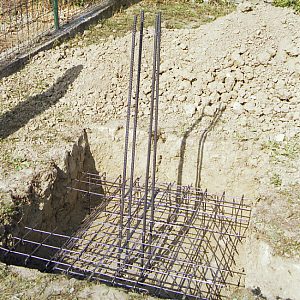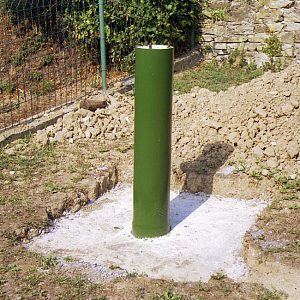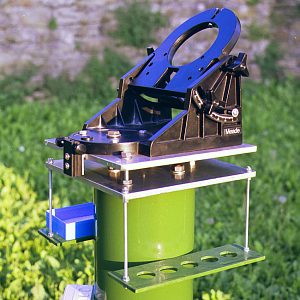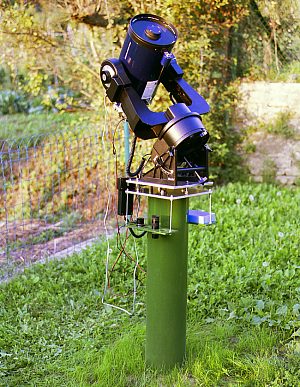
Every amateur has an observatory in his dreams, where everything is ready-to-use and one has just to open the dome and turn on the instruments. Actually this is a demanding and expensive dream and you will go to the trouble of doing it only if you have a very good sky!
A pier is an easier and faster alternative. It is easy to built and quite inexpensive, but really it's a saving of time for assembly and polar alignment. In this page you can find the description of the one I have built in my garden.

 |
First of all we dug a pit for the plinth: sizes are 100cm x 100cm (3.3 feet) and the deep is 65cm (2.2 feet). A steel framework was laid down in it with four arms that come up for 100cm. Around them we put a plastic tube ø 20 cm (8"): it is the "mould" for the pier. Finally I put an electric covering, a plastic tube ø 2 cm with four wires that crosses the garden, the plinth and come out from the pier at 60 cm (2') from the ground. |
 |
At that time we was ready to fill with cement the plinth and the tube, paing attention to the horizontality of the upper end. A mask with three screw bolts (ø 14mm) was positioned on the top before the concrete had become solid: they need to connect the wedge to the pier by two plates. you can see a more detailed description of the two plates with some drawings |
 |
We let the plastic tube in its position: painted of green it is a good finish for the pier. At the end of the electric covering I put a watertight box with the connections for the telescope, the Pictor and the Kendrick dew remover. A thin layer of ground over the plinth let the grass grow again. |

 |
This is not a new solution to connect the Meade standard wedge to the pier: two metallic plates that allow to adjust the horizontality of the telescope. An useful add are the two little plates for eyepieces and accessories hung to the inferior plate. All these components live permanently in the garden, covered by a plastic bag. When I want use the telescope I just have to put the fork on the wedge and connect the short electric wires. |
|
Here is: isn't it a beauty?
|
 |
|
Please note: I am not an engineer (actually I'm a medical doctor): for this reason I am not sure that this is a good work. My only intention is to share my ideas and my experience about this subject and I can't assume the liability of this drawings. If you want to reproduce my work please check every detail whit an architect or you will do it under your responsibility. Thank you for your understanding. |
back to the observatory page
back to the techniques page
back to the home page